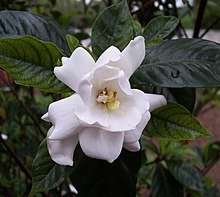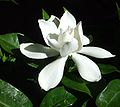Gardenia
| Gardenia | |
|---|---|

| |
| Gardenia jasminoides | |
| Scientific classification | |
| Kingdom: | Plantae |
| Clade: | Tracheophytes |
| Clade: | Angiosperms |
| Clade: | Eudicots |
| Clade: | Asterids |
| Order: | Gentianales |
| Family: | Rubiaceae |
| Subfamily: | Ixoroideae |
| Tribe: | Gardenieae |
| Genus: | Gardenia J.Ellis |
| Species | |
Gardenia is a genus of flowering plants in the coffee family, Rubiaceae, native to the tropical and subtropical regions of Africa, Asia, Madagascar and Pacific Islands,[1] and Australia.[2]
The genus was named by Carl Linnaeus and John Ellis after Alexander Garden (1730–1791), a Scottish-born American naturalist.[3]
Description
Gardenias are evergreen shrubs and small trees growing to 1–15 metres (3.3–49.2 ft) tall. The leaves are opposite or in whorls of three or four, 5–50 centimetres (2.0–19.7 in) long and 3–25 centimetres (1.2–9.8 in) broad dark green and glossy with a leathery texture.
The flowers are solitary or in small clusters, white, or pale yellow, with a tubular-based corolla (botany) with 5–12 lobes (petals) from 5 to 12 centimetres (2.0 to 4.7 in) diameter. Flowering is from about mid-spring to mid-summer, and many species are strongly scented.
Phytochemistry
Many of the native gardenias of the Pacific Islands and elsewhere in the paleotropics possess a diverse array of natural products. Methoxylated and oxygenated flavonols, flavones, and triterpenes accumulate on the vegetative- and floral-buds as yellow to brown droplets of secreted resin. Many focused phytochemical studies of these bud exudates have been published, including a population-level study of two rare, sympatric species of the Fiji Islands, G. candida and G. grievei.[4] The evolutionary significance of the gums and resins of gardenias in attracting or repelling invertebrate herbivores, has yet to be explored by ecologists.[citation needed]
Systematics
As of July 2022[update] Plants of the World Online recognises 128 species in this genus, as follows:[5]
- Gardenia actinocarpa Puttock
- Gardenia anapetes A.C.Sm.
- Gardenia angkorensis Pit.
- Gardenia annamensis Pit.
- Gardenia aqualla Stapf & Hutch.
- Gardenia archboldiana Merr. & L.M.Perry
- Gardenia aubryi Vieill.
- Gardenia barnesii Merr.
- Gardenia beamanii Y.W.Low
- Gardenia boninensis (Nakai) Tuyama ex T.Yamaz.
- Gardenia brachythamnus (K.Schum.) Launert
- Gardenia brevicalyx Rakoton. & A.P.Davis
- Gardenia brighamii H.Mann
- Gardenia buffalina (Lour.) Poir.
- Gardenia cambodiana Pit.
- Gardenia candida A.C.Sm.
- Gardenia carinata Wall. ex Roxb.
- Gardenia carstensensis Wernham
- Gardenia chanii Y.W.Low
- Gardenia chevalieri Pit.
- Gardenia clemensiae Merr. & L.M.Perry
- Gardenia collinsiae Craib
- Gardenia cornuta Hemsl.
- Gardenia coronaria Banks
- Gardenia costulata Ridl.
- Gardenia crameri Tirveng.
- Gardenia cuneata Kurz
- Gardenia dacryoides A.Cunn. ex Puttock
- Gardenia elata Ridl.
- Gardenia epiphytica Jongkind
- Gardenia erubescens Stapf & Hutch.
- Gardenia esculenta Stokes
- Gardenia ewartii Puttock
- Gardenia faucicola Puttock
- Gardenia fiorii Chiov.
- Gardenia flava (Lour.) Poir.
- Gardenia fosbergii Tirveng.
- Gardenia fucata R.Br. ex Benth.
- Gardenia fusca E.T.Geddes
- Gardenia gardneri Puttock
- Gardenia gjellerupii Valeton
- Gardenia gordonii Baker
- Gardenia grievei Horne ex Baker
- Gardenia griffithii Hook.f.
- Gardenia gummifera L.f.
- Gardenia hageniana Gilli
- Gardenia hainanensis Merr.
- Gardenia hansemannii K.Schum.
- Gardenia hillii Horne ex Baker
- Gardenia hutchinsoniana Turrill
- Gardenia imperialis K.Schum.
- Gardenia invaginata Merr. & L.M.Perry
- Gardenia ixorifolia R.Br. ex Hook.f.
- Gardenia jabiluka Puttock
- Gardenia jasminoides J.Ellis
- Gardenia kabaenensis Y.W.Low
- Gardenia kakaduensis Puttock
- Gardenia kamialiensis Takeuchi
- Gardenia lacciflua K.Krause
- Gardenia lamingtonii F.M.Bailey
- Gardenia lanutoo Reinecke
- Gardenia latifolia Aiton
- Gardenia leopoldiana De Wild. & T.Durand
- Gardenia leschenaultii D.Dietr.
- Gardenia longistipula Y.W.Low
- Gardenia magnifica E.T.Geddes
- Gardenia mannii H.St.John & Kuykendall
- Gardenia manongarivensis Rakoton. & A.P.Davis
- Gardenia maugaloae Lauterb.
- Gardenia megasperma F.Muell.
- Gardenia moszkowskii Valeton
- Gardenia mutabilis Reinw. ex Blume
- Gardenia nitida Hook.
- Gardenia obtusifolia Roxb. ex Hook.f.
- Gardenia ornata K.M.Wong
- Gardenia oudiepe Vieill.
- Gardenia ovularis F.M.Bailey
- Gardenia pallens Merr. & L.M.Perry
- Gardenia panduriformis Pierre ex Pit.
- Gardenia papuana F.M.Bailey
- Gardenia philastrei Pierre ex Pit.
- Gardenia posoquerioides S.Moore
- Gardenia propinqua Lindl.
- Gardenia psidioides Puttock
- Gardenia pterocalyx Valeton
- Gardenia pyriformis A.Cunn. ex Benth.
- Gardenia racemulosa Korth.
- Gardenia reflexisepala N.H.Xia & X.E.Ye
- Gardenia reinwardtiana Blume
- Gardenia remyi H.Mann
- Gardenia resinifera Roth
- Gardenia resiniflua Hiern
- Gardenia resinosa F.Muell.
- Gardenia rupicola Puttock
- Gardenia rutenbergiana (Baill. ex Vatke) J.-F.Leroy
- Gardenia sambiranensis Rakoton. & A.P.Davis
- Gardenia saxatilis E.T.Geddes
- Gardenia scabrella Puttock
- Gardenia schlechteri Bonati & Petitm.
- Gardenia schwarzii Puttock
- Gardenia sericea Puttock
- Gardenia similis (Craib) Craib
- Gardenia siphonocalyx Valeton
- Gardenia sokotensis Hutch.
- Gardenia sootepensis Hutch.
- Gardenia stenophylla Merr.
- Gardenia storckii Oliv.
- Gardenia subacaulis Stapf & Hutch.
- Gardenia subcarinata (Corner) Y.W.Low
- Gardenia taitensis DC.
- Gardenia tannaensis Guillaumin
- Gardenia ternifolia Schumach. & Thonn.
- Gardenia tessellaris Puttock
- Gardenia thailandica Tirveng.
- Gardenia thunbergia Thunb.
- Gardenia tinneae Kotschy & Heuglin
- Gardenia transvenulosa Verdc.
- Gardenia trochainii Sillans
- Gardenia tropidocarpa Wernham
- Gardenia truncata Craib
- Gardenia tubifera Wall. ex Roxb.
- Gardenia urvillei Montrouz.
- Gardenia vernicosa Merr. & L.M.Perry
- Gardenia vilhelmii Domin
- Gardenia vitiensis Seem.
- Gardenia vogelii Hook.f.
- Gardenia volkensii K.Schum.
- Gardenia vulcanica K.M.Wong
Cultivation and uses
Gardenia plants are prized for the strong sweet scent of their flowers, which can be very large in size in some species.[6]
Gardenia jasminoides (syn. G. grandiflora, G. Florida) is cultivated as a house plant. This species can be difficult to grow because it originated in warm humid tropical areas. It demands high humidity to thrive, and bright (but not direct) light. It flourishes in acidic soils with good drainage and thrives on [20-23 C temperatures (68-74 F)][7] during the day and 15-16 C (60 F) in the evening. Potting soils developed especially for gardenias are available. G. jasminoides grows no larger than 18 inches in height and width when grown indoors. In climates where it can be grown outdoors, it can attain a height of 6 feet. If water touches the flowers, they will turn brown.[8][volume & issue needed][unreliable source?]
In Eastern Asia, Gardenia jasminoides is called zhīzi (栀子) in China, chija (치자) in Korea, and kuchinashi (梔) in Japan. Its fruit is used as a yellow dye,[9] used on fabric and food (including the Korean mung bean jelly called hwangpomuk). Its fruits are also used in traditional Chinese medicine for their clearing, calming, and cooling properties.[10]
In France, gardenias are the flower traditionally worn by men as boutonnière when in evening dress. In The Age of Innocence, Edith Wharton suggests it was customary for upper-class men from New York City to wear a gardenia in their buttonhole during the Gilded Age.[11]
Sigmund Freud remarked to the poet H.D. that gardenias were his favorite flower.[12]
In Tiki culture, "Donn Beach", aka Don the Beachcomber, frequently wore a fresh lei of gardenias almost every day at his Tiki bars, allegedly spending $7,800 for flowers over the course of four years in 1938.[13] He named one of his drinks the Mystery Gardenia cocktail. Trader Vic frequently used the gardenia as a flower garnish in his Tiki drinks, such as in the Scorpion and Outrigger Tiara cocktails.[14]
Several species occur in Hawaii, where gardenias are known as naʻu or nānū.
Crocetin is a chemical compound usually obtained from Crocus sativus, which can also be obtained from the fruit of Gardenia jasminoides.[15] Gordonin is a novel methoxylated flavonol secreted in golden-colored resinous droplets of Gardenia gordonii, which is one of several critically endangered species of the Fiji Islands. Phytochemical studies of these resin droplets have been published, including a population-level study of two other rare, sympatric species on Vanua Levu Island of the Fiji Archipelago, G. candida and G. grievei.[16]
Hattie McDaniel famously wore gardenias in her hair when she accepted an Academy Award, the first for an African American, for Gone with the Wind. Mo'Nique Hicks later wore gardenias in her hair when she won her Oscar as a tribute to McDaniel.
Gallery
-
Gardenia brighamii
-
Gardenia jasminoides 'Plena'
-
Gardenia jasminoidesl 'Radicans'
-
Gardenia psidioides
-
Gardenia taitensis
-
Gardenia thunbergia by Edith Struben (1868-1936)
-
Gardenia volkensii flower
-
Gardenia volkensii flowers, foliage, fruit
-
Blooming stages of gardenia flower (1 of 6)
-
Blooming stages of gardenia flower (2 of 6)
-
Blooming stages of gardenia flower (3 of 6)
-
Blooming stages of gardenia flower (4 of 6)
-
Blooming stages of gardenia flower (5 of 6)
-
Blooming stages of gardenia flower (6 of 6)
References
- ^ Tao Chen; Charlotte M. Taylor, "Gardenia J. Ellis, Philos. Trans. 51: 935. 1761", Flora of China online, vol. 19
- ^ Puttock, C.F. âA REVISION OF GARDENIA ELLIS (RUBIACEAE) FROM NORTH-EASTERN QUEENSLAND.â Austrobaileya, vol. 2, no. 5, 1988, pp. 433â449. JSTOR, www.jstor.org/stable/41738712. Accessed 2 Sept. 2020.
- ^ "LXXXII. An account of the plants Halesia and Gardenia : In a letter from John Ellis, Esq; F. R. S. To Philip Carteret Webb, Esq; F. R. S". Philosophical Transactions of the Royal Society of London. 51: 929–935. 1759. doi:10.1098/rstl.1759.0084. S2CID 186210416.
- ^ Miller, J. M. and S. Sotheeswaran. 1993. Bud exudate composition and ecogeography of Fijian Gardenia species (Rubiaceae). Biotropica 25(1): 117-122
- ^ "Gardenia J. Ellis". Plants of the World Online. Royal Botanic Gardens, Kew. Retrieved 12 July 2022.
- ^ "Gardenia Flowers Gardening". 7 February 2023. Retrieved 11 March 2023.
- ^ "Gardenia Care". Archived from the original on 2009-01-25. Retrieved 2009-01-15.
- ^ Reader's Digest. Success with House Plants. The Reader's Digest Association, Inc. New York/Montreal. 217
- ^ Ozaki, A.; Kitano, M.; Furusawa, N.; Yamaguchi, H.; Kuroda, K.; Endo, G. (2002), "Genotoxicity of gardenia yellow and its components", Food and Chemical Toxicology, 40 (11): 1603–1610, doi:10.1016/S0278-6915(02)00118-7, PMID 12176087
- ^ "Zhi Zi (Gardenia, Cape Jasmine Fruit), Fructus Gardeniae Jasminoidis - Chinese Herb". Archived from the original on 2011-09-03. Retrieved 2011-08-02.
- ^ Edith Wharton, The Age of Innocence, Wordsworth Classic, 1999, p. 4
- ^ H.D. (Hilda Doolittle). "Tribute to Freud." New Directions, Boston 1974 p11
- ^ Bitner, Arnold (2001). Hawai'i Tropical Rum Drinks by Don the Beaschcomber. Honolulu: Mutual Publishing. p. 18.
- ^ Vic, Trader (1972). Bartender's Guide, Revised (revised ed.). Garden City, NY: Doubleday & Co. p. 179.
- ^ Yamauchi, M; Tsuruma, K; Imai, S; Nakanishi, T; Umigai, N; Shimazawa, M; Hara, H (2011). "Crocetin prevents retinal degeneration induced by oxidative and endoplasmic reticulum stresses via inhibition of caspase activity". European Journal of Pharmacology. 650 (1): 110–9. doi:10.1016/j.ejphar.2010.09.081. PMID 20951131.
- ^ Miller, J. M. and S. Sotheeswaran. 1993. Bud exudate composition and ecogeography of Fijian Gardenia species (Rubiaceae). Biotropica 25(1): 117-122














